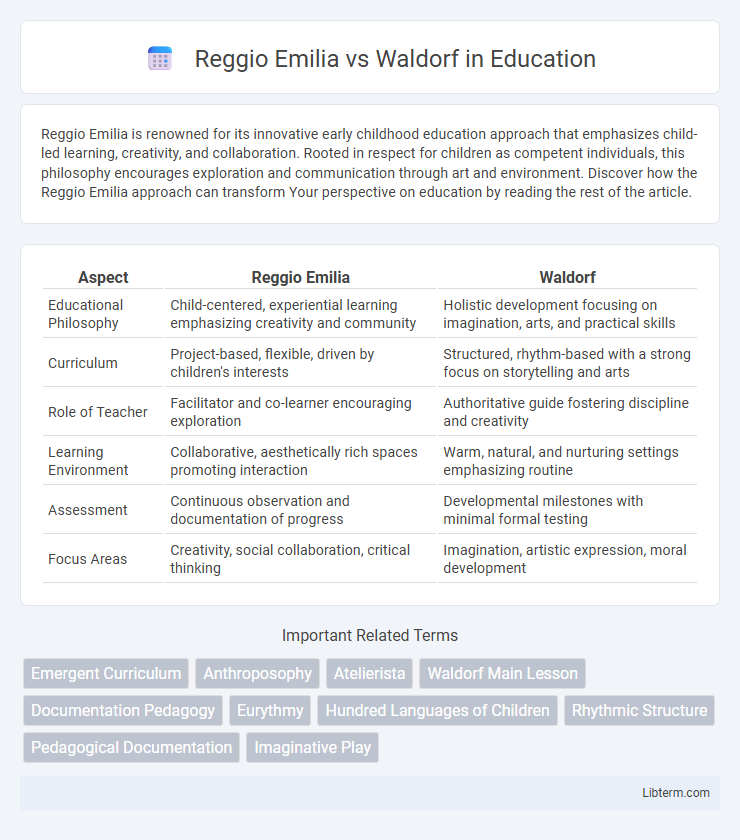Reggio Emilia is renowned for its innovative early childhood education approach that emphasizes child-led learning, creativity, and collaboration. Rooted in respect for children as competent individuals, this philosophy encourages exploration and communication through art and environment. Discover how the Reggio Emilia approach can transform Your perspective on education by reading the rest of the article.
Table of Comparison
| Aspect | Reggio Emilia | Waldorf |
|---|---|---|
| Educational Philosophy | Child-centered, experiential learning emphasizing creativity and community | Holistic development focusing on imagination, arts, and practical skills |
| Curriculum | Project-based, flexible, driven by children's interests | Structured, rhythm-based with a strong focus on storytelling and arts |
| Role of Teacher | Facilitator and co-learner encouraging exploration | Authoritative guide fostering discipline and creativity |
| Learning Environment | Collaborative, aesthetically rich spaces promoting interaction | Warm, natural, and nurturing settings emphasizing routine |
| Assessment | Continuous observation and documentation of progress | Developmental milestones with minimal formal testing |
| Focus Areas | Creativity, social collaboration, critical thinking | Imagination, artistic expression, moral development |
Introduction to Reggio Emilia and Waldorf Approaches
Reggio Emilia and Waldorf approaches emphasize child-centered education with distinct philosophies and methodologies. The Reggio Emilia approach focuses on experiential learning, collaboration, and environment as the "third teacher," encouraging inquiry and creativity in early childhood settings. In contrast, the Waldorf approach integrates artistic expression, imagination, and rhythm in its curriculum, fostering holistic development through storytelling, arts, and hands-on activities.
Philosophical Foundations: Comparing Core Beliefs
Reggio Emilia emphasizes child-led learning, viewing the environment as the "third teacher" and promoting collaboration, creativity, and exploration through projects based on children's interests. Waldorf education centers on holistic development, nurturing imagination, creativity, and moral growth through a structured curriculum aligned with developmental stages, inspired by Rudolf Steiner's anthroposophy. Both prioritize experiential learning but diverge in their approach; Reggio Emilia values emergent curriculum shaped by community participation, while Waldorf follows a predetermined rhythm focusing on artistic expression and spiritual development.
Curriculum Design and Structure
The Reggio Emilia curriculum emphasizes child-led exploration with an emergent, flexible structure that adapts to students' interests, promoting project-based learning and collaboration. Waldorf education follows a structured, age-specific curriculum rooted in developmental stages, integrating arts, academics, and practical activities with a focus on imagination and holistic growth. Both prioritize experiential learning, but Reggio Emilia is more fluid and responsive, while Waldorf maintains a consistent, sequential pedagogical rhythm.
Role of the Teacher: Guide vs. Facilitator
In the Reggio Emilia approach, the teacher acts as a guide, carefully observing and responding to children's interests to co-construct knowledge through exploration and inquiry. The Waldorf model positions the teacher as a facilitator, leading structured activities and nurturing imagination while supporting holistic development through a predetermined curriculum. Both roles emphasize fostering creativity and independence, yet the Reggio Emilia teacher adapts fluidly to children's evolving ideas, whereas the Waldorf educator provides consistent thematic guidance.
Learning Environments and Classroom Aesthetics
Reggio Emilia classrooms emphasize natural materials, open spaces, and children's artwork, fostering creativity and exploration through a child-centered environment that adapts to their interests. Waldorf environments focus on warm, rhythmic, and home-like settings with muted colors, handcrafted toys, and natural elements to nurture imagination and a connection to nature. Both approaches prioritize simplicity and sensory engagement but differ in structure, with Reggio Emilia encouraging dynamic documentation and collaboration, while Waldorf maintains a consistent, calming atmosphere aligned with developmental phases.
Importance of Art and Creativity
Reggio Emilia emphasizes art and creativity as integral tools for self-expression and cognitive development, encouraging children to explore diverse materials and collaborate on projects that foster critical thinking. Waldorf education integrates art through daily activities like storytelling, painting, and music, aiming to nurture imagination, emotional growth, and holistic development. Both approaches recognize creativity as essential for cultivating problem-solving skills and fostering a deep connection with the learning process.
Parental and Community Involvement
Reggio Emilia education emphasizes strong parental and community involvement, fostering collaboration through regular parent-teacher meetings, workshops, and community events that support children's learning experiences. Waldorf education encourages parental participation by promoting home environments aligned with Waldorf principles and organizing seasonal festivals and activities that engage families and community members. Both approaches view parental and community involvement as essential to creating enriched, supportive educational environments that nurture child development.
Assessment Methods and Student Evaluation
Reggio Emilia assessment methods emphasize observational documentation and qualitative analysis, capturing children's learning through portfolios, photographs, and narrative records to support individualized growth. Waldorf education focuses on holistic evaluation through continuous teacher observation and storytelling, avoiding formal testing to nurture creativity and emotional development. Both approaches prioritize developmental progress over standardized assessments, fostering intrinsic motivation and personalized learning experiences.
Social-Emotional Development Focus
Reggio Emilia education emphasizes social-emotional development through collaborative group projects, encouraging children to express emotions and build relationships within a community setting. Waldorf education prioritizes nurturing emotional intelligence by integrating imaginative play and art, fostering empathy and self-awareness in a rhythmical daily routine. Both approaches support social-emotional growth but differ in methods, with Reggio Emilia focusing on social interaction and Waldorf on individual emotional expression.
Choosing Between Reggio Emilia and Waldorf: Key Considerations
Choosing between Reggio Emilia and Waldorf education involves evaluating your child's learning style and developmental needs. Reggio Emilia emphasizes project-based learning, collaboration, and a strong connection to the environment, while Waldorf focuses on imaginative play, creativity, and rhythm. Consider the pedagogical philosophy, classroom environment, and teaching approach to align with your family's values and your child's unique personality.
Reggio Emilia Infographic

 libterm.com
libterm.com